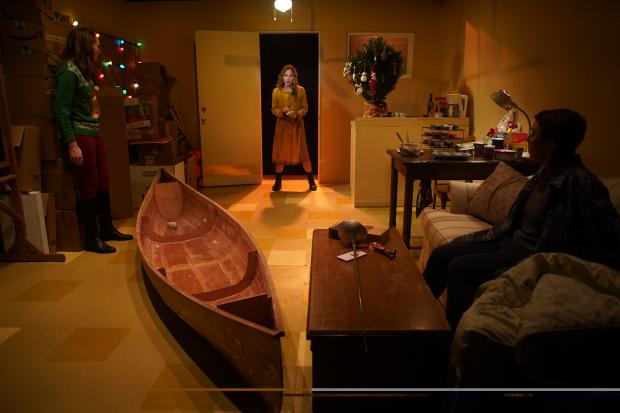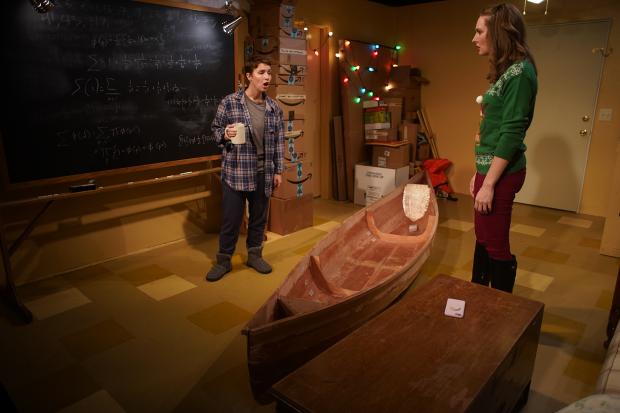Jami Brandli’s Sisters Three has an intriguing, promising premise that is similar to Amy Heckerling’s 1995 Clueless starring Alicia Silverstone and 2011’s From Prada to Nada, which updated and adapted to contemporary milieus Jane Austen’s 19th century novels, respectively, 1816’s Emma and 1811’s Sense and Sensibility. In Sisters Three Brandli locates the real life Brontë siblings, who wrote later in the 19th century than Austen did, in the 21st century.
Adapting the Brontës to the social media era is an inspired idea, and Brandli captures the artsy, antsy, angsty anguish that reportedly troubled the three sisters - and their brother, Branwell, who is a palpable offstage presence in this clever production. The playwright extrapolates from what is known of the siblings’ real lives in her modern day-set 90 minute or so one-acter that takes place on a college campus, although it was not clear to me where - but probably closer to New York than Yorkshire.
Dana DeRuyck portrays “EJ” - or Emily Jane Brontë, whose sole novel, Wuthering Heights, was published when she was 29 in 1847, just a year before her untimely death. ALL of the Brontës died young, which could explain a lot about their agonizing, and Sisters Three captures, to use an Austen-ian word, their “sensibility,” although the witty Brandli and her comedic cast play much of this for laughs.
DeRuyck’s EJ is a mathematical academic at a university, and the onstage props include a canoe and blackboard full of chalk equations intended to try to prove an elusive theorem. EJ is a lesbian who, like Emily’s immortal character Cathy Earnshaw, yearns to consummate a forbidden love. In Sisters Three this is an offstage character who is EJ’s lab assistant and may or may not be gay. Her name is “Heather” - a witty reference to Heathcliff, Cathy’s Wuthering Heights rough-around-the-edges flame (not to the toffee bar or cartoon cat).
Anne, who was the youngest of the sisterly trio, is depicted by Kara Hume as a publicist and social media maven who lives by the tweet. Apparently her PR ventures are not faring too well as she is secretly shacking up in EJ’s small on-campus unit, which is a violation of college regulations. The tall, slim, leggy Hume plays Anne with comic panache, but there is an edge to the character: [PLOT SPOILER ALERT] Anne may have had an incestuous relationship with her older brother Branwell, who has committed suicide some time before the curtain has lifted.
About 60% of the way into Sisters Three the play is very talky. Well, I guess this is to be expected as we are experiencing portrayals of a threesome of literary lights. EJ and Anne verbally spar and what action there is besides talking involves preparing cupcakes, which are particular favorites of EJ. The small cakes are rather humorously called “Rochesters.” Although some illiterate cinephiles in the audience thought this referred to Jack Benny’s chauffeur, it is actually a droll reference to Mr. Rochester, the brooding Lord of Thornfield Hall where Jane is a governess in Charlotte’s masterpiece Jane Eyre.
Almost two thirds into this dialogue-driven dramedy the stage suddenly erupts. Without revealing and ruining exactly what happens, let’s just say that oral dueling gives way to some, shall we say, Errol Flynn-Basil Rathbone type of action, which is actually rather skillfully executed. (Note to Nervous Nellies: Don’t sit in the front row of this pocket-sized theatre.)
Then, enter Charlotte - and all hell breaks loose. Robyn Cohen is high-larious, playing the author of Jane Eyre as an “Eyre-head”, who has escaped from a hippie commune. Given all of Charlotte’s psychedelic, free love, countercultural references one would think Sisters Three was set in 1968, instead of 2018. In any case, Cohen - who has acted opposite Jeff Goldblum, Melanie Griffith and Bill Murray on the stage and screen - proceeds to steal the show with her depiction of a demented if not demonically-possessed Charlotte. Her deftly played insane intensity is a joy and sight to behold and by itself worth the price of admission.
The playwright interweaves the rich fantasy life of the Brontës into her comedy-drama. Living in Victorian England the siblings had to contend with intense sexual repression, which is a recurring theme in their brilliant published works. Despite the fact that by 1837 the UK’s monarch was actually a woman, Britain was still an uptight patriarchal society and the female Brontës were forced to publish under male pen names. (And Dalton Trumbo and the other Blacklisted screenwriters thought they had it bad!) Yet they were admirable women who, with their literary prowess became pioneering feminist icons, which filters through at times in Sisters Three, despite its goofiness. Unfortunately, as said, all of the Brontës died young, which of course, is no laughing matter.
Given my reference to the authoress of 1813’s beloved Pride and Prejudice, it’s interesting to note that DeRuyck appeared in a Hollywood Fringe work called Jane Austen’s Emma Frankenstein; she’s also a member of the Sacred Fools Theater Company. Hume acted in another piece by Brandli called Through the Eye of a Needle (voted “Top Ten” by Stage Raw) and appeared in TV programs such as the soap opera Days of Our Lives - presumably good preparation for playing a Brontë. Oy vey - Annie McVey adeptly directs her ensemble and their onstage pyrotechnics.
Presented by the Inkwell Theater, this is the world premiere of Sisters Three, which was a finalist for the Source Festival and a semi-finalist for The Bay Area Playwrights Foundation. As previously alluded to, the VS. Theatre is a diminutive domain - it was almost like watching a play in your living room. But there is definitely a place for this - according to the playbill, the Inkwell Development LAB “is focused on developing new plays through a collaborative workshop process” bringing “artistic brainpower… to bear upon the play.” Participating bards are “recipients of The Lerner Fellowship.”
Fun Facts:
For my money, the best film version of Jane Eyre is what I believe to be the first feature adaptation of the novel - 1943’s black and white classic starring what is arguably the definitive Edward Rochester, an impeccable, smoldering Orson Welles in his prime (before all that prime beef caught up with the wunderkind) opposite Joan Fontaine as the beleaguered, besotted governess plus Margaret O’Brien and Agnes Moorehead. There have been at least six big and little screen productions of Jane Eyre and Welles is in good company - other leading men who have essayed the role of Rochester include George C. Scott, William Hurt, Timothy Dalton and Michael Fassbender (although not until Sisters Three has a cupcake played the part).
Who co-wrote the screenplay for this 1943 screen adaptation of Charlotte’s 1847 gothic sizzler? Aldous Huxley (best known for writing Brave New World and dropping acid with Cary Grant), Welles collaborator John Houseman (who’d later terrify Harvard law students in 1973’s The Paper Chase) and the movie’s British director, Robert Stevenson, who went on to helm 1964’s Mary Poppins and another 1965 Disney flick with arguably a more Bronte-like title: That Darn Cat!
Wuthering Heights, too, has been repeatedly filmed, at least eight times, including a version wherein Dalton (Timothy, not Trumbo) also plays Heathcliff. On Nov. 30 a British version was released in the UK, and a 2011 rendition added some interracial spice to the Brontë brew. But William Wyler’s 1939 classic, which received seven Oscar noms and movie maestro Gregg Toland won in the cinematography category, is arguably the best iteration, with its script by renowned playwrights Charles MacArthur and Ben Hecht, with David Niven as Edgar, Merle Oberon as Cathy and Sir Laurence Olivier as the definitive Heathcliff. “Oh Heathcliff!” “Oh Cathy!”
There have also been various biopics about the Brontës but Brandli’s Sisters Three is probably the most original - and wackiest. It is for the more adventurous theatergoer, with a taste for the literary and dash of daffiness, combined with female-driven themes and characters.
The Inkwell Theater presents Sisters Three, which plays at 8:00 p.m. Fridays and Saturdays, 2:00 p.m. on Sundays (added performances at 8:00 p.m. on Thursdays Dec. 20 and Dec. 27 and Mondays Jan. 7 and Jan. 14) through January 20, 2019. VS Theatre is located at 5453 W. Pico Blvd., Los Angeles, 90010. For reservations: https://inkwelltheater.com .
L.A.-based reviewer/historian Ed Rampell is co-presenting a screening of Pasolini’s “The Gospel According to St. Matthew” 7:00 p.m., Dec. 27 at The L.A. Workers Center, 1251 S. St. Andrews Place, L.A., CA 90019. The third edition of “The Hawaii Movie and Television Book” co-authored by Rampell is now available at: https://mutualpublishing.com/product/the-hawaii-movie-and-television-book/ .


